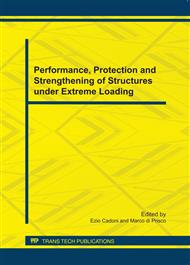p.545
p.551
p.559
p.565
p.571
p.577
p.583
p.589
p.594
Shear Behavior of Rectangular Beams Strengthened with either Carbon or Steel Fiber Reinforced Polymers
Abstract:
The aim of this study is to upgrade the shear capacity of reinforced concrete (R/C) beams strengthened with either Carbon (CFRP) or Steel (SRP) fiber Reinforced Polymers with strips having the form of either closed or open hoop external transverse reinforcement. This investigation also includes the use an anchoring device. Seven prototype specimens in need of shear strength upgrade were tested having a span of 3000mm. The strengthened R/C beams along with a non-strengthened control R/C beams were tested monotonically under four point bending loading conditions. The experimental results indicate that the shear failure of the closed hoop strengthened beams is accompanied with the tensile fracture of the CFRP/SRP strips together with an increase in the shear capacity. A considerable increase in the shear strength was observed when open hoop CFRP/SRP strips with no anchoring were used; however, the debonding of these strips posed a limitation to this upgrade. When these open hoop CFRP/SRP strips were provided with anchoring devices the shear strength of the R/C beams was further increased and the shear failure was accompanied this time by either the fracture of the CFRP/SRP strips or the failure of the anchoring system. In conclusion, a shear strengthening system for R/C beams utilizing open hoop CFRP/SRP strips with properly designed anchoring it is easily applicable, it increases significantly the shear capacity of such R/C beams and it exploits at the same time the high tensile strength of these fiber polymer materials in a cost effective way. An analytical procedure used to predict the shear strength for of such R/C beams yielded good comparison with the measured values.
Info:
Periodical:
Pages:
571-576
Citation:
Online since:
July 2011
Price:
Сopyright:
© 2011 Trans Tech Publications Ltd. All Rights Reserved
Share:
Citation:


